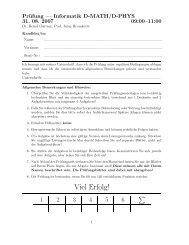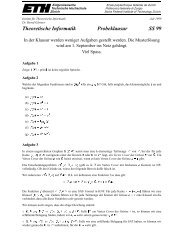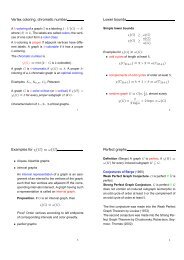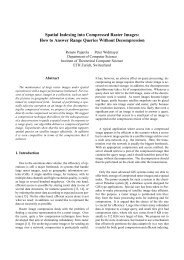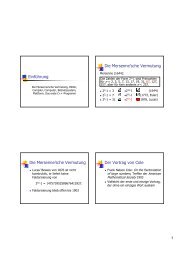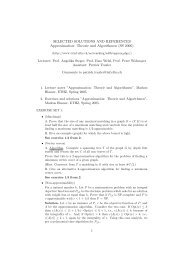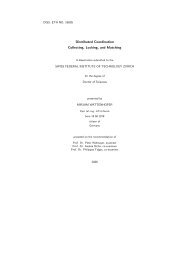Chapter 4 Line Sweep - TI
Chapter 4 Line Sweep - TI
Chapter 4 Line Sweep - TI
You also want an ePaper? Increase the reach of your titles
YUMPU automatically turns print PDFs into web optimized ePapers that Google loves.
<strong>Chapter</strong> 4. <strong>Line</strong> <strong>Sweep</strong> CG 2012<br />
Questions<br />
11. How can one test whether a polygon on n vertices is simple? Describe an<br />
O(n logn) time algorithm.<br />
12. How can one test whether two simple polygons on altogether n vertices intersect?<br />
Describe an O(n logn) time algorithm.<br />
13. How does the line sweep algorithm work that finds all k intersecting pairs<br />
among n line segments in R 2 ? Describe the algorithm, using O((n + k) logn)<br />
time and O(n) space. In particular, explain the data structures used, how event<br />
points are handled, and how to cope with degeneracies.<br />
14. Given two line segments s and t in R 2 whose endpoints have integer coordinates<br />
in [0,2 b ); suppose s and t intersect in a single point q, what can you<br />
say about the coordinates of q? Give a good (tight up to small additive number<br />
of bits) upper bound on the size of these coordinates. (No need to prove tightness,<br />
that is, give an example which achieves the bound.)<br />
15. What is the degree of a predicate and why is it an important parameter? What<br />
is the degree of the orientation test and the incircle test in R 2 ? Explain the<br />
term and give two reasons for its relevance. Provide tight upper bounds for the<br />
two predicates mentioned. (No need to prove tightness.)<br />
16. What is the map overlay problem and how can it be solved optimally using<br />
degree two predicates only? Give the problem definition and explain the term<br />
“interior-disjoint”. Explain the bundle-sweep algorithm, in particular, the data<br />
structures used, how an event point is processed, and the concept of witnesses.<br />
References<br />
[1] Ivan J. Balaban, An optimal algorithm for finding segment intersections. In<br />
Proc. 11th Annu. ACM Sympos. Comput. Geom., pp. 211–219, 1995, URL<br />
http://dx.doi.org/10.1145/220279.220302.<br />
[2] Jon L. Bentley and Thomas A. Ottmann, Algorithms for reporting and counting<br />
geometric intersections. IEEE Trans. Comput., C-28, 9, (1979), 643–647, URL<br />
http://dx.doi.org/10.1109/TC.1979.1675432.<br />
[3] Timothy M. Chan, A simple trapezoid sweep algorithm for reporting red/blue segment<br />
intersections. In Proc. 6th Canad. Conf. Comput. Geom., pp. 263–268, 1994,<br />
URL https://cs.uwaterloo.ca/~tmchan/red_blue.ps.gz.<br />
[4] Bernard Chazelle, Triangulating a simple polygon in linear time. Discrete Comput.<br />
Geom., 6, 5, (1991), 485–524, URL http://dx.doi.org/10.1007/BF02574703.<br />
42



